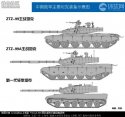well, although we call it a light tank,it is actually a light MBT .....not your traditional light tank....think of it more like the new japanese type 10
it is required(design purpose) to effectively take on early 3-gen MBT,like t72s....
the new lt weighs about circa 35tons,almost the same as the old 59s...
about the armor, @2000m, its turret(with heavy modular armour)suppose to have decent protection against old soviet rounds....
Where do you get the design purpose to effectively deal with 3rd generation tanks like the T72?
Why would heavy modular armor make the turret have decent protection? it is still 35 tonnes which means there is very well limit on how much armor is carried.
Even if it is the latest Chobham ceramic armor, or even soviet silica based variants, resistance to KE rounds would not be that much better than RHA, even against CE rounds, you are looking at maybe 1.6X RHA of the same thickness. how thick do you think the armor is? 300 mm RHAe? I cannot see this tank having that thick of armor. The T55 or Type 59 at 39 tonne you used as a comparison, have 205mm RHA base on the turret, and an additional spaced BDD "brow" armor gave it 380 mm RHAe vs KE and 450mm RHAe vs CE.
If your intended comparison is the T72, then you are looking at the turret with Indian T72M1 with 280mm thick armor, estimated 420mm RHAe against KE and 490mm Vs CE. Now, India also field ERA on their T72, both the Kontakt 1 and the Kontakt 5; the latter brings armor protection against KE to around 800 RHAe and CE to around 1200mm RHAe...
Gunwise, the 2A46 125mm:
1968 3BM12 have 280mm RHAe penetration @ 2000m
1972 3BM15 have 310mm RHAe penetration @ 2000m
1976 3BM22 have 380mm RHAe penetration @ 2000m
Even 2A20 115mm found on older tanks:
1960s BM-3 have 300mm RHAe penetration @ 2000m (tungsten carbide)
1962 BM-6 have 246mm RHAe penetration @ 2000m (steel)
1970s BM21 have 330mm RHAe penetration @ 2000m (DU)
From tank net,
Chinese Type-86 105mm DU 460mm(from "short" 105)/480mm(from "long" 105) at 2km
Chinese Type-93 105mm DU 510mm("short")/540mm("long") at 2km
Chinese Type-95 105mm DU 580mm at 2km (from "long" Type-83A 105mm)
i.e. unless the T72 cannot acquire target at 2 km, then the "Light MBT" will still be vulnerable; thats before considering that the T72 operators will likely be fielding standard current export rounds capable of 550-600mm RHAe penetration.
Well... There was one case... Although it was a medium tank. The Sherman tank of WW2 was a lightweight compared to the monstrosities coming from Germany and Russia. Most of the second world war... Well they nicknamed them after a cigarette lighter Ronson who's motto was lights on the first strike. Against the German Tiger tanks going into battle was normally considered a act of suicide. Except near the end of the war there was a change the British took out the anemic 75mm and swapped in a 76mm gun this new gun packed a much better punch and killed Germany's top tank ace in a Tiger2. So a lightweight with a proper gun can take a heavyweight.
Fire support. If its a light tank and not a attempt at a t10 clone (which I doubt) then the aim is fire support. As to why not on a IFV chassis? Mobile gun systems like the Stryker MGS have the worst of both worlds. They tend to be very very tall making them harder to transport normally end up becoming way to top heavy, automated turrets limit defence options the mechanics of the turret eat up protection and space for equipment (Like Air conditioning) they tend to be heavier then there supposed to be and just awkward.
TE, I don't think that there are any guarantees in competition and war; there are anecdotal evidence that under equiped troops can take out better armed ones, yes, a banzai charge would work some times, but it is unreliable in war.
The final form of the sherman is 30 tonnes, it is not a light tank in comparison to other medium tanks of the era, like the T34 at 26 tonnes, and the Panzer IV at 25 tonnes.
I think generally, people will feel safer when they sit in a heavier armored tank with a bigger gun than the one shooting at you.

